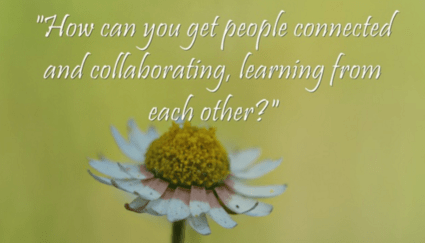“How can I make my webinars, which are usually 30 to 60 minutes long, more interactive?” I asked myself after being a talking head in my last webinar. Facilitating webinars at TCEA on a regular basis, I definitely want to know better approaches for engaging the audience, enabling them to move from being just listeners to active participants. With that imperative motivating me, I stopped for a moment and asked some colleagues, “How do you make your webinars more interactive?”
Join the ongoing TCEA Microsoft Innovative Educator (MIE) SkypeChat via your mobile device or online. Explore and share concepts at the intersection of teaching, learning, leading and technology!
From the wealth of advice these veteran webinar facilitators shared, here are five nuggets of wisdom I gleaned from their words:
- “Are you a rookie, veteran, or webinar fanatic?” That’s how Peggy Reimers (@preimers) starts out her Lunch and Learn webinars (free for TCEA.org members, by the way). Kick your webinar off with a poll or survey to get folks going. You can use a variety of polling tools, whether it is Poll Everywhere, the one built into Adobe Connect, or a Twitter-based poll. The goal is to engage your audience, to help them feel a part of the online meeting so you can begin building a relationship. You crack the ice that naturally exists between strangers.
- “A person’s name is the sweetest sound to them” is a paraphrase of Dale Carnegie’s famous quote, which he shared in his book How to Win Friends & Influence People. Make a point of always welcoming everyone to the conversation by name, even if you just learned their name from their login.
- To facilitate collaboration, Jennifer Bergland (@jbergland) recommends creating a Padlet that participants can add their ideas to in writing, audio, or video. You can share the web link to the Padlet, send them off to work, and then bring them back at the appropriate time to share their thoughts. Some webinar facilitators, like TCEA member Susan Reeves (@susanfreeves) from the Education Service Center Region 20, even use Padlets for unconference session planning, a great distributive way to interact with collaborations. Play music (some like the Jeopardy television show tune) while they are “gone” and then end the music when they are supposed to return. You can also take advantage of tools like Quizizz and Kahoot! to connect people. Setting a time limit works, too, the equivalent of “calibrate your digital watches” to ensure people return to share what they’ve worked on.
- Peggy Reimers also suggests that webinar facilitators “create a breakout room, something you can do in Adobe Connect, so participants can work together. Be sure to grant one person audio/microphone rights to facilitate communication.” At the end, pull them all back into the “common room” so they can share their insights and learning. In this way, you build community. Or have the group speaker create a Vocaroo and then share the link to the audio in the common room.
- “With OneNote Class Notebook, you can easily have a shared virtual space for collaboration to modify an existing document, maybe use a rubric to assess a document or creation,” I thought after watching the Class Notebook intro video. You can also use Google Draw to create a collaborative whiteboard space where participants can fill in information and contribute ideas, taking advantage of digital ink to articulate their points in visual shorthand. Diana Benner (@diben) shares “I created a vocabulary matching activity. They [participants] have to move the vocabulary term and match it to the definition.” While we have seen this type of activity in other venues, I never would have thought to use it to engage webinar participants and to do it in Google Draw.
And, since five tips may not be enough, you might try what I did in my last webinar. Set up a webquest focusing on each aspect of your topic, then invite people to work through the process, collaborating and creating as they go. At the end of the webinar, they can share what they have created. Whether you are a rookie or veteran webinar facilitator, participants will appreciate your efforts to involve them in the learning. Why not make the effort to connect, collaborate, and create with them?

